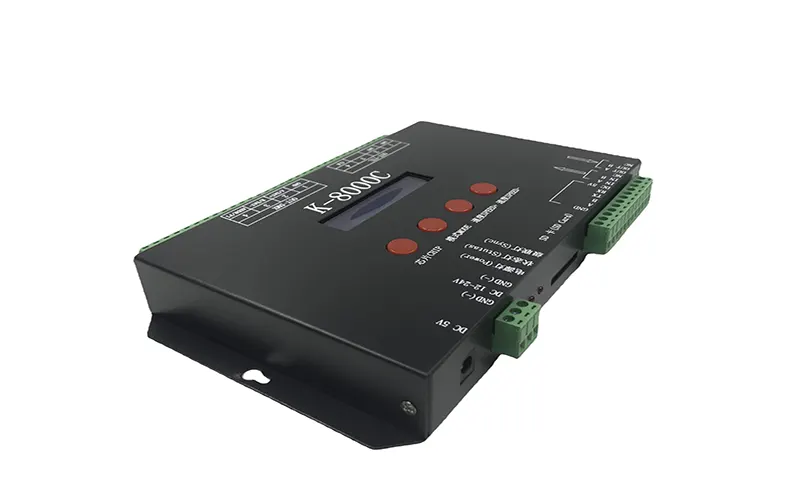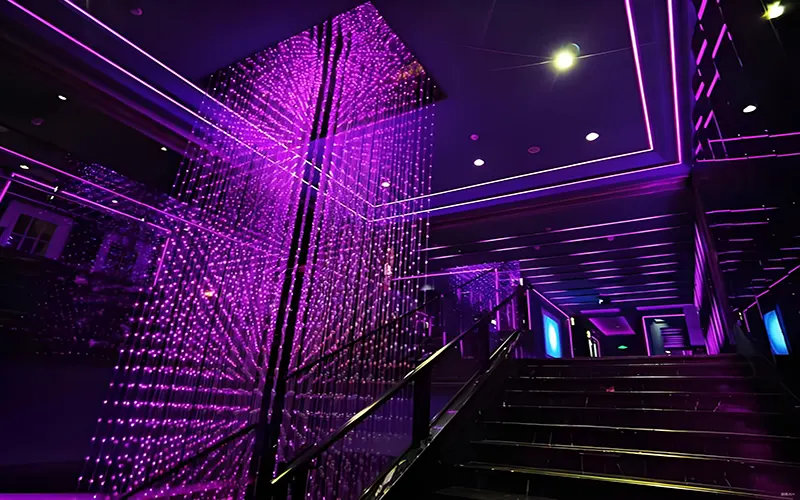LED strip lights have become an essential lighting product for stage lighting, architectural contours, and high-end homes. DMX control has become the core technology for achieving precise, dynamic LED lighting. However, many users are concerned about a key question: “How many LED strips can a single DMX controller control?” . This not only relates to the achieved lighting effects but also directly impacts project costs and system stability. It’s not a simple number but is determined by multiple factors. Including DMX protocol limitations, LED strip type, decoder configuration, and power supply design. More details, pls read What Does DMX Stand for Lighting?
What is DMX? How Does It DMX Control LED Strips?
DMX512 (short for Digital Multiplex) is a standard digital communication protocol. Originally developed for controlling stage dimmers and now widely used in professional lighting.
In essence, it can be understood as a precise “command language”. That allows controllers (such as lighting consoles) to communicate with receiving devices (such as DMX512 LED strips).

Standard LED Strips vs. DMX512 LED Strips: Control Methods
- Standard LED Strips: For example, a standard RGB LED strip without a DMX IC. It typically uses a simple PWM signal to control overall color changes.
- DMX LED Strips: DMX LED strips have a DMX512 signal IC. Their core lies in the integrated DMX decoder (or chip). This decoder receives DMX signals and translates them into instructions that the LED strip can execute. More information, pls read What is the Difference Between DMX 512 and SPI LED Strip?
How Does DMX Control DMX LED Strips?
Signal Transmission:
The entire control process begins with the DMX controller. The controller transmits data packets at high speed and continuously via an XLR data cable (commonly three- or five-core) or a wireless DMX transmitter. Each DMX data packet contains control information for 512 channels. Each with a value ranging from 0 to 255, representing an 8-bit digital signal.
For example, a channel value of 0 indicates the light is off, 255 indicates full brightness. And values in between correspond to different brightness or color changes.
The DMX controller refreshes these data packets at a rate of 30-44 times per second, enabling real-time dynamic changes in the light without noticeable delay.
Address Recognition
Each DMX LED strip or each DMX decoder has a unique start address to determine its position within the entire DMX system.
When the controller sends a signal containing 512 channels, all devices receive this data simultaneously, but each decoder only “listens” to the channels corresponding to its own address range.
For example:
- If the start address of an RGB LED strip is 1, it will read signals from channels 1, 2, and 3;
- If the start address of the next LED strip is 4, it will read signals from channels 4, 5, and 6;
And so on. The controller can then control the brightness and color of each LED strip individually. Through this address allocation mechanism, the DMX control system can manage hundreds or even thousands of lighting devices simultaneously without signal conflicts.
Command Execution
When the DMX controller sends a command, such as “set the value of channel 1 to 255,” the decoder immediately recognizes that “channel 1” falls within its control.
If this channel controls red light, all the red LEDs on the light strip will instantly light up. Simultaneously, the values of channels 2 and 3 control the brightness ratio of green and blue. Therefore, by adjusting the data combination of the three channels. The controller can precisely mix various colors, achieving full-color RGB color variation.
In more complex scenarios, if RGBW or RGBIC light strips are used. Each pixel or group of LEDs may require 4-5 channels for control. The controller can then achieve richer effects. Such as flowing light, chasing light, breathing light, gradient light, scene synchronization, and other advanced dynamic modes.
Precise Control and Large-Scale Synchronization
DMX systems enable pixel-level control, with their main advantage being address-based precision control.
In large-scale light shows, stage performances, and building facade lighting. Engineers can design extremely complex dynamic scenes using DMX control software (such as Madrix, Sunlite, and GrandMA).
Hundreds of meters of light strips can be divided into thousands of independent pixels, each with its own defined color and brightness; multiple DMX controllers can also achieve perfect coordination of the entire lighting effect through master-slave synchronization.
This high-precision, real-time responsive control method makes DMX systems the preferred control standard for professional stage lighting, architectural illumination, theme parks, and musical fountains.

What Factors Affect the DMX LED Strips Capacity?
When we consider how many meters of DMX512 LED strip a single DMX controller can control. To answer the question “how many strips can it control,” you need a comprehensive understanding of the following four interrelated elements.
The Essence of the DMX Protocol
The foundation of the DMX protocol is a “Universe”. A DMX Universe has a fixed 512 channels. This is the hard limit of the DMX512 protocol and the cornerstone of all computations.
Each channel controls a light parameter, typically the brightness value of a color channel, ranging from 0 (off) to 255 (brightest).
Chip Type and Number of Channels in LED Strips
This is the most critical variable determining the bandwidth. Different types of LED strips require vastly different numbers of channels per “pixel” (an independently controllable unit).
- RGB LED strip (3-in-1): One pixel (containing R, G, and B chips) requires 3 DMX channels.
- RGBW LED strip (4-in-1): Adds a white channel to the RGB designation; one pixel requires 4 DMX channels.
- Pixel LED strip (e.g., WS2812B): Each smart pixel contains an IC chip, also requiring 3 channels (R, G, B) for control.
- Monochrome white LED strip: The simplest, requiring only 1 channel per pixel to control brightness.
DMX Controller Output Capabilities and Models
Different brands and models of DMX controllers vary in the number of output ports and signal stability. Therefore, it’s essential to confirm these details with the supplier before purchasing a DMX512 controller.
- Single-port controller (1 Universe) → 512 channels
- Multi-port controller (e.g., 4 Universes) → 2048 channels
- High-end Art-Net controller → Supports tens of thousands of channels
LED Power Supply
The DMX controller only sends control signals and does not provide power to the LED strips. Therefore, power must be supplied by a separate, sufficiently powerful power source.
If the power supply is insufficient to drive all the LED strips, even with normal signals, the strips will exhibit problems such as insufficient brightness, color distortion, or flickering. When calculating power supply capacity, the power consumption per meter of the LED strip and its total length must be considered.
How Do I Calculate the Number of LED Strips a DMX Control Can Connect to?
If you are looking to choose the right controller for your DMX512 LED strip, you can refer to the following details.
Controlled Pixels = 512 ÷ Number of Channels Required per LED Strip
Examples:
- RGB LED strip (3 channels) → Controls approximately 170 pixels
- RGBW LED strip (4 channels) → Controls approximately 128 pixels
- Multi-channel system (4 Universe) → Controls approximately 680 RGB pixels
Furthermore, if the LED strip is long and each segment shares the same signal (non-pixel control). The number of pixels that can be controlled can be expanded by connecting a repeater or a DMX decoder in parallel.
What is the Role of a DMX Decoder in Controlling LED Strip Lights?
A DMX controller itself only sends digital signals and cannot directly drive ordinary LED strip lights. The role of a DMX decoder is to convert DMX signals into PWM signals for use by the LED strip lights. A DMX controller, on the other hand, can control DMX512 LED strips without any conversion.

- Signal Conversion: Converts standard DMX512 signals into signal protocols (such as PWM, serial data, etc.) that LED strips can recognize.
- Address Assignment: The decoder is responsible for identifying and executing instructions from specific DMX addresses, ensuring that each LED strip performs its designated function.
- Integrated vs. Discrete Forms: The decoder can be directly integrated onto the LED strip PCB (i.e., a “DMX strip”), or it can be a separate external box used to connect ordinary non-DMX LED strips to a DMX system.
Problems with DMX-controlled LED strips
Many DMX system failures stem from fundamental errors. If you encounter the following problems, you can refer to the troubleshooting guide below. Here are common problems and solutions: More, What is the Use of DMX512 Controller?
- LED strip not responding or partially not lighting: First, check if the DMX address is set correctly to avoid duplication; confirm that the positive and negative terminals (Data+ / Data-) of the signal lines are not reversed.
- Signal attenuation or loss: A repeater was not used when the line exceeded 300 meters; unshielded twisted-pair cable caused interference.
- Flickering lights or code skipping: A 120Ω terminating resistor was not installed at the end of the bus, causing signal reflection.
- Decoder burnout: The power line was mistakenly connected to the DMX signal port, or the power supply was reversed.
- Control asynchrony: Multiple buses are not synchronized with the clock, or a poor-quality controller is used.
- Electromagnetic interference: The DMX line and power line are run parallel for too long; they should be crossed or kept at least 15cm apart.
How to Expand a DMX System to Control More LED Strips?
When a single DMX bus cannot meet the demand, it can be expanded in the following ways:
- Using a DMX splitter: A single output port is split into multiple independent branches, each capable of supporting up to 30 devices, overcoming physical node limitations.
- Adding DMX repeaters: Regenerates signals over long distances, preventing attenuation and supporting greater distances and more devices.
- Multiple controllers or network protocols: For very large projects (such as architectural lighting), Art-Net or sACN protocols can be used to transmit DMX data over Ethernet, supporting thousands of channels and enabling centralized control.
- Cascading decoders: Some intelligent decoders support cascading outputs, extending signals on the same bus.
Conclusion
In summary, the number of LED strips a DMX controller can control drive is a dynamic value determined by the number of protocol channels, the type of LED strip chip, controller performance, and power supply. You can easily estimate the system’s capability limits by referring to the calculation formula in this article.
If you are planning to build a DMX lighting system or are unsure how to calculate the number of controllers, please visit Neonledstrip.com or contact our technical team. We provide professional DMX LED strip solutions, controller selection, and project consultation to help you create a safe, efficient, and precisely synchronized lighting experience.
FAQs
DMX is a standardized 512-channel serial control protocol, commonly used for long-distance control in applications such as stage and architectural lighting; while SPI is a point-to-point signal control, more suitable for scenarios requiring high-resolution changes, such as pixel lights and LED screens. DMX is more stable and has stronger compatibility.
Yes, but only if your decoder and power supply voltage are compatible with the LED strip. DMX signals are simply a data transmission protocol and are voltage-independent.
Yes, there are distance limitations. We recommend a standard DMX signal transmission distance of approximately 300 meters, depending on cable quality and environmental interference.
No, DMX cables are only used to transmit control signals and cannot provide power. LED strips must be powered by a separate constant voltage or constant current power supply. Connecting a power source to the DMX interface will immediately damage the decoder or controller. Always ensure that signal cables and power cables are wired separately and connected correctly.
